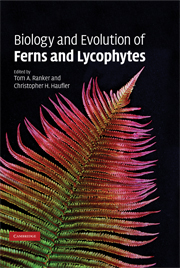Book contents
- Frontmatter
- Contents
- List of contributors
- Preface
- Acknowledgments
- Part I Development and morphogenesis
- Part II Genetics and reproduction
- Part III Ecology
- Part IV Systematics and evolutionary biology
- 12 Species and speciation
- 13 Phylogeny and evolution of ferns: a paleontological perspective
- 14 Diversity, biogeography, and floristics
- 15 Fern phylogeny
- 16 Fern classification
- Index
- References
16 - Fern classification
Published online by Cambridge University Press: 11 August 2009
- Frontmatter
- Contents
- List of contributors
- Preface
- Acknowledgments
- Part I Development and morphogenesis
- Part II Genetics and reproduction
- Part III Ecology
- Part IV Systematics and evolutionary biology
- 12 Species and speciation
- 13 Phylogeny and evolution of ferns: a paleontological perspective
- 14 Diversity, biogeography, and floristics
- 15 Fern phylogeny
- 16 Fern classification
- Index
- References
Summary
Introduction and historical summary
Over the past 70 years, many fern classifications, nearly all based on morphology, most explicitly or implicitly phylogenetic, have been proposed. The most complete and commonly used classifications, some intended primarily as herbarium (filing) schemes, are summarized in Table 16.1, and include: Christensen (1938), Copeland (1947), Holttum (1947, 1949), Nayar (1970), Bierhorst (1971), Crabbe et al. (1975), Pichi Sermolli (1977), Ching (1978), Tryon and Tryon (1982), Kramer (in Kubitzki, 1990), Hennipman (1996), and Stevenson and Loconte (1996). Other classifications or trees implying relationships, some with a regional focus, include Bower (1926), Ching (1940), Dickason (1946), Wagner (1969), Tagawa and Iwatsuki (1972), Holttum (1973), and Mickel (1974). Tryon (1952) and Pichi Sermolli (1973) reviewed and reproduced many of these and still earlier classifications, and Pichi Sermolli (1970, 1981, 1982, 1986) also summarized information on family names of ferns. Smith (1996) provided a summary and discussion of recent classifications.
With the advent of cladistic methods and molecular sequencing techniques, there has been an increased interest in classifications reflecting evolutionary relationships. Phylogenetic studies robustly support a basal dichotomy within vascular plants, separating the lycophytes (less than 1% of extant vascular plants) from the euphyllophytes (Figure 16.1; Raubeson and Jansen, 1992, Kenrick and Crane, 1997; Pryer et al., 2001a, 2004a, 2004b; Qiu et al., 2006). Living euphyllophytes, in turn, comprise two major clades: spermatophytes (seed plants), which are in excess of 260000 species (Thorne, 2002; Scotland and Wortley, 2003), and ferns (sensu Pryer et al. 2004b), with about 9000 species, including horsetails, whisk ferns, and all eusporangiate and leptosporangiate ferns.
Information
- Type
- Chapter
- Information
- Biology and Evolution of Ferns and Lycophytes , pp. 417 - 467Publisher: Cambridge University PressPrint publication year: 2008
References
Accessibility standard: Unknown
- 75
- Cited by
